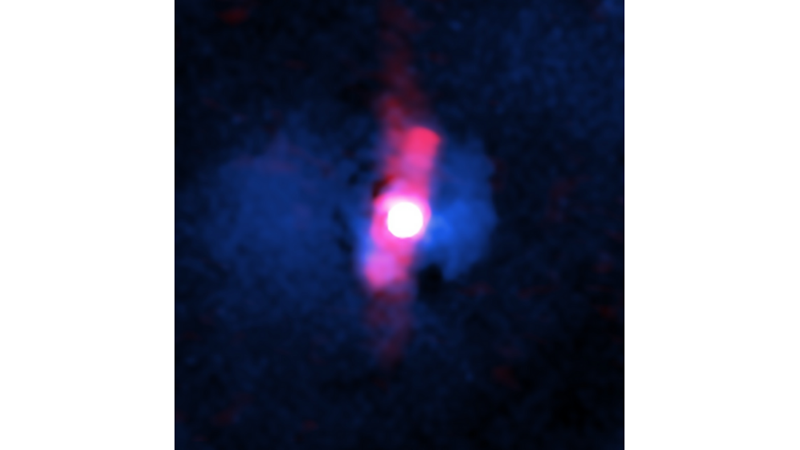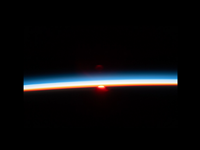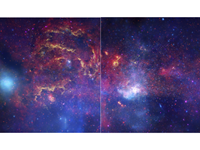Scientists using Chandra have detected a bright supermassive black hole that does not meet expectations. Located about 3.4 billion light years from Earth, H1821+643 has much less influence on its surroundings than expected.
This image shows a quasar, a rapidly growing supermassive black hole that, as reported in our last press release, is not achieving what astronomers expected of it. Data from NASA's Chandra X-ray Observatory (blue) and radio data from NSF's Karl G. Jansky Very Large Array (red) reveal some evidence of this quasar's disappointing impact on its host galaxy.
This quasar, known as H1821+643, is about 3.4 billion light-years from Earth. Quasars are a rare and extreme class of supermassive black holes that produce intense radiation and sometimes powerful jets that angrily pull material inwards. H1821+643 is the closest quasar to Earth in a galaxy cluster.
Quasars differ from other supermassive black holes at the centres of galaxy clusters because they attract more material at a higher rate. Astronomers have found that non-quasar black holes, which grow at moderate speeds, influence their surroundings by preventing hot intergalactic gas from cooling too much. This in turn regulates the growth of stars around the black hole.
However, the effect of quasars is not so well known. This new study of H1821+643 shows that quasars - although very active - may be less important in directing the fate of their host galaxy and cluster than some scientists expected.
To reach this conclusion, the team used Chandra to study the hot gas in which H1821+643 and its host galaxy reside. However, the bright X-rays from the quasar made it difficult to study the weaker X-rays from the hot gas. The researchers carefully removed the X-ray flare to reveal what the effect of the projected black hole is in the new composite image, which shows X-rays from the hot gas in the cluster surrounding the quasar. This allowed them to see that the quasar actually has little effect on its surroundings.
Using Chandra, the team found that the gas density near the black hole at the centre of the galaxy is much higher and gas temperatures are much lower than in more distant regions. Scientists expect hot gas to behave this way when there is little or no energy input (typically caused by explosions from a black hole) to prevent the hot gas from cooling and flowing towards the centre of the cluster.
Image description:
This composite image shows a quasar, a rare and extreme class of supermassive black hole located about 3.4 billion light-years from Earth.
At the centre of the image is a bright, white, circular light that looks like the beam of a flashlight pointed directly at you. Surrounding the circular structure is a fuzzy, rod-shaped structure of red-coloured radio light, slightly larger than the width of the white light. The red bar also extends above and below the white light and runs in a straight line from one o'clock position to seven o'clock position.
On either side of the red bar, X-ray light is present as brighter blue, thin clouds of hot gas that are closer to the red and white features. The brighter clouds represent denser gas.
Source: Nasa Chandra X-Ray


 Nielawore
Nielawore









Yorum yazmak için lütfen giriş yapınız